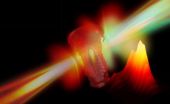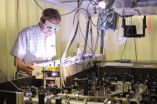LCs are dendritic cells (DCs) found in the outermost layer of the skin. DCs are a critical component of the immune system because they are the only cells able to 'see' and 'alert' other responding immune cells to initiate a protective response against harmful foreign invaders. Like sentries of the immune system, DCs are strategically positioned where they are likely to encounter harmful pathogens. Identifying the source of these specialised immune cells may hold exciting possibilities to novel strategies for vaccination and treatment of autoimmune diseases and inflammatory skin disorders.
In contrast to other DCs which are constantly replaced by a circulating pool of bone marrow-derived precursors, LCs has the interesting ability to maintain themselves throughout life. While it is established that these long-lived sentry cells of the skin arise from precursors that are recruited to the skin prior to birth, this is the first time that the exact origin of the precursors of LCs is revealed through advanced fate-mapping technique (a method of tracing cell lineages to their embryonic origin).
In this study, published in the June issue of Journal of Experimental Medicine, Dr Florent Ginhoux, and his team demonstrated that adult LCs originate from two distinct embryonic lineages in two succeeding waves. The first wave of precursor cells from the yolk sac 'seed' the skin before the onset of the foetal liver. Interestingly, the team discovered that at the later stage of development, the yolk-sac precursors are largely replaced by a type of white blood cells from the foetal liver.
Said Dr Ginhoux, Principal Investigator of SIgN, "Whether this unique dual origin of Langerhans cells influences their ability to maintain skin integrity or dictate their specialised immune functions in response to microbes and vaccines needs to be examined. But having identified their origin surely opens new possibilities of using them as novel vaccination strategies or as therapeutic tool for treating inflammatory skin diseases like psoriasis."
Scientific Director of SIgN, Professor Paola Castagnoli said, "This discovery sheds light on understanding the complexities of the immune system, in particular the relationship between immune responses and human diseases. It will bring us closer to our goal of discovering novel ways of treating and preventing a range of immune diseases that will impact healthcare." ###
Notes for editor:
1. The research findings described in this media release can be found in the 7 May online issue of The Journal of Experimental Medicine under the title, "Adult Langerhans cells derive predominantly from embryonic fetal liver monocytes with a minor contribution of yolk sac-derived macrophages" by Guillaume Hoeffel1, Yilin Wang1, Melanie Greter2,3, Peter See1, Pearline Teo1, Benoit Malleret1, Marylene Leboeuf2,3, Donovan Low1, Guillaume Oller1, Francisca Almeida1, Sharon H.Y. Choy4 , Marcos Grisotto5, Laurent Renia1, Simon J. Conway6, E. Richard Stanley7, Jerry K.Y. Chan8,9,10, Lai Guan Ng1, Igor M. Samokhvalov11, Miriam Merad2,3, and Florent Ginhoux1
1 Singapore Immunology Network, Agency for Science, Technology and Research (A*STAR), IMMUNOS Building #3-4, BIOPOLIS, 138648, Singapore
2 Department of Gene and Cell Medicine and 3 The Immunology Institute, Mount Sinai School of Medicine, New York, NY 10029
4 Biological Resource Centre, A*STAR, #07-01 Centros, 138668, Singapore
5 Centro Universitário do Maranhão – UNICEUMA, São Luis, MA, Brazil
6 Herman B Wells Center for Pediatric Research, Indiana University School of Medicine, Indianapolis, IN 46202
7 Department of Developmental and Molecular Biology, Albert Einstein College of Medicine, Bronx, NY 10461
8 Experimental Fetal Medicine Group, Yong Loo Lin School of Medicine, National University of Singapore, Singapore ,
9 Reproductive Medicine, KK Women's and Children's Hospital, Singapore
10 Cancer and Stem Cell Biology Program, Duke-NUS Graduate Medical School, Singapore
11 Laboratory for Stem Cell Biology, Center for Developmental Biology, Institute of Physical and Chemical Research Kobe, Kobe 6500047, Japan
Abstract of this article can be accessed from http://jem.rupress.org/content/early/2012/05/01/jem.20120340.short?rss=1
AGENCY FOR SCIENCE, TECHNOLOGY AND RESEARCH (A*STAR)
For media queries and clarifications, please contact:
Sarah Chang (Dr.)
Corporate Communications
Agency for Science, Technology and Research
Tel: (65) 6826 6442
Email: chang_kai_chen@a-star.edu.sg
About the Singapore Immunology Network (SIgN)
The Singapore Immunology Network (SIgN), officially inaugurated on 15 January 2008, is a research consortium under the Agency for Science, Technology and Research (A*STAR)'s Biomedical Research Council. The mandate of SIgN is to advance human immunology research and participate in international efforts to combat major health problems. Since its launch, SIgN has grown rapidly and currently includes 200 scientists from 25 different countries around the world working under 20 renowned principal investigators. At SIgN, researchers investigate immunity during infection and various inflammatory conditions including cancer and are supported by cutting edge technological research platforms and core services.
Through this, SIgN aims to build a strong platform in basic human immunology research for better translation of research findings into clinical applications. SIgN also sets out to establish productive links with local and international institutions, and encourage the exchange of ideas and expertise between academic, industrial and clinical partners and thus contribute to a vibrant research environment in Singapore. For more information about SIgN, please visit www.sign.a-star.edu.sg.
About the Agency for Science, Technology and Research (A*STAR)
The Agency for Science, Technology and Research (A*STAR) is the lead agency for fostering world-class scientific research and talent for a vibrant knowledge-based and innovation-driven Singapore. A*STAR oversees 14 biomedical sciences and physical sciences and engineering research institutes, and six consortia & centres, located in Biopolis and Fusionopolis as well as their immediate vicinity.



